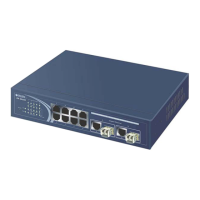
Do you have a question about the Ruby Tech ES-2310C and is the answer not in the manual?
| Brand | Ruby Tech |
|---|---|
| Model | ES-2310C |
| Category | Network Router |
| Language | English |
Provides a high-level summary of the manual's content and structure.
Offers a comprehensive description of the ES-2310C switch's features and functionalities.
Lists the essential items for verifying the contents of the ES-2310C package.
Details the hardware and management capabilities offered by the ES-2310C switch.
Illustrates the physical layout of the ES-2310C, including front panel components.
Describes the buttons, LEDs, and ports located on the front panel of the switch.
Details the interfaces and connectors found on the rear panel of the ES-2310C.
Lists and describes the various optional transceiver modules supported by the switch.
Guides users through the initial setup and startup procedures for the ES-2310C.
Provides instructions for the physical installation and cabling of the ES-2310C switch.
Details the process of mounting the switch chassis into standard rack equipment.
Specifies the necessary cabling standards and guidelines for optimal network performance.
Explains how to configure the switch for management via serial or Ethernet interfaces.
Details the steps for configuring the switch using a serial RS-232 connection.
Outlines the process for managing the switch via its Ethernet port.
Covers the essential parameters for IP addressing, including IP, subnet mask, and gateway.
Illustrates common network deployment scenarios and applications for the ES-2310C.
Provides an introduction to the web interface and displays initial system status upon login.
Details how to view comprehensive system status and configuration parameters.
Guides users through configuring IP settings, including DHCP and manual IP assignment.
Explains how to set the system time manually or automatically via NTP.
Covers managing user accounts, including creating, modifying, and deleting them.
Details security configurations to control user access and network access types.
Explains the Virtual Stack Management (VSM) feature for centralized control of multiple switches.
Introduces the port management functions, including status, configuration, and counters.
Displays real-time status information for each port on the switch.
Allows configuration of port operational parameters like speed, duplex, and flow control.
Shows summary traffic counts (bytes, packets) for each port.
Provides detailed traffic statistics and error counts for each port.
Covers SNMP settings, community names, and trap host configurations for network management.
Explains the DHCP Boot function for managing broadcast traffic during network startup.
Details IGMP Snooping for efficient handling of IP multicast traffic.
Introduces VLAN functionality for network segmentation and security.
Allows selection between Port-based and Tag-based VLAN modes.
Guides on creating, editing, and deleting Tag-based VLAN groups.
Explains setting Port VLAN IDs and ingress filtering rules.
Covers managing Port-based VLAN groups, including creation and editing.
Details MAC address table information, maintenance, and static MAC entries.
Explains the GVRP protocol for dynamic VLAN registration and management.
Covers Spanning Tree Protocol configuration to prevent network loops.
Displays the current status and parameters of the Spanning Tree Protocol.
Details STP configuration options like Bridge Priority and Hello Time.
Configures STP settings for individual ports, including path cost and priority.
Explains link aggregation (trunking) for increasing bandwidth and redundancy.
Details 802.1x port-based network access control for user authentication.
Covers setting up event notifications via email, SMS, and traps.
Manages switch configurations, including saving, restoring, and exporting settings.
Provides options to save and restore switch configurations for backup and recovery.
Explains using TFTP to back up and reload configuration files.
Covers security features like port mirroring and access control lists.
Allows setting ingress and egress bandwidth limits and storm control.
Covers Quality of Service settings for prioritizing network traffic.
Provides tools for system self-diagnostics, including loopback and ping tests.
Allows configuration of the TFTP server IP address for file transfers.
Displays system log data and events.
Guides users on upgrading the switch firmware.
Explains how to reboot the switch.
Covers manual and automatic logout procedures.
Introduces the Command Line Interface for switch management.
Details the login process for accessing the CLI.
Lists and explains available CLI commands.
Describes general CLI commands applicable across different modes.
Details CLI commands specific to different operational modes.
Provides troubleshooting steps for 'no link' LED status issues.
Offers solutions to common connectivity and configuration problems.
Lists the key features and technical capabilities of the ES-2310C managed switch.
Provides pin assignment details for the DB-9 null modem cable used for console connection.